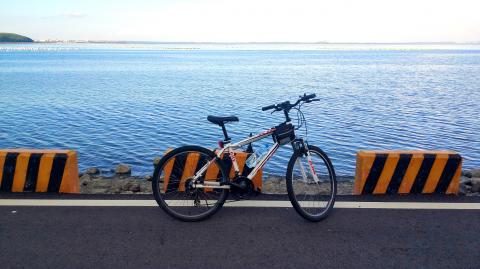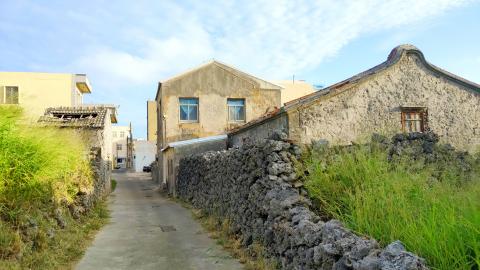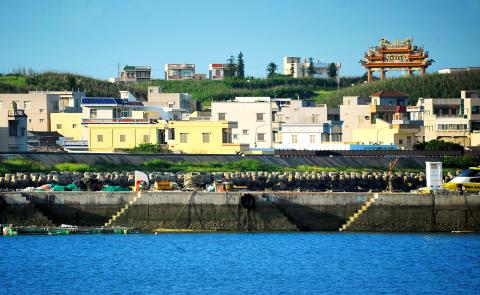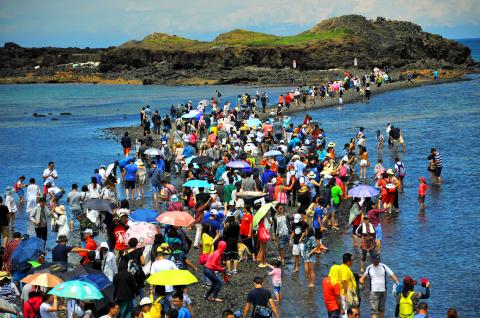My guesthouse owner looks increasingly puzzled as I tell her about my cycling adventure. “Why did you go there?” she asks. “There’s nothing to see.”
“That’s the point,” I reply.
I had purposely arrived on a weekday, but the tourist hordes had already overrun Magong (馬公), the only city in the scenic archipelago of Penghu off the coast of Chiayi. It turns out they were here for the Penghu International Fireworks Festival, which takes place every Monday and Thursday until the end of this month.

Photo: Han Cheung, Taipei Times
But as I soon learn, it’s not that hard to avoid the crowds. People seem to follow a pretty standard formula while touring Penghu’s main four islands, all of which are connected by bridge: rent a scooter and follow the suggested route, only stopping at the marked attractions on the tourist map. For example, after I was done snapping photos of the hundreds of people with parasols trying to crowd their way across a tiny land bridge that had just appeared with the receding tide, all I had to do was walk a few hundred meters to find an empty mountain path with stunning views of the blue expanse.
But why is such an idyllic path officially called the “Invincibly High View Mountain Loop (無敵嗨景環山草徑)? The main issue with these attractions are not just the crowds, but how they’ve been all coated with a thick layer of cuteness that has obfuscated any sense of authenticity. As if the jolly anime sculptures and kitschy, selfie-ready murals painted on dolled-up century-old structures weren’t enough, I was just enjoying the fireworks when a man suddenly proposed on stage to his girlfriend.
The announcer makes them kiss for 10 seconds and then wishes them eternal happiness. Normally I wouldn’t have minded, but I had become misanthropic after a day’s bombardment with all things saccharine. I run back to my guesthouse to wash off the sentimentality. If I still drank alcohol, I’d go find the trashiest bar possible.

Photo: Han Cheung, Taipei Times
SELFIE OVERLOAD
I had been wandering and relaxing for an hour at Jinguitou (金龜頭), an expansive cannon fortress built in 1887. Like most man-made attractions on Penghu, it has been unnecessarily restored to the point where the walls are shinier than a modern-day army base. This seems to have been recent work; even the official Penghu National Scenic Area Web site shows the fort in its original state, blemishes and all.
But I like the fact that I have a splendid view of the ocean beyond clusters of cacti, and that my only companions are the creepy fake soldiers who repeatedly startle me by suddenly barking out commands. I had escaped via just a five-minute walk over the hill from Dusingshi Village (篤行十村), Taiwan’s oldest military dependent’s village that has both fortunately and tragically been turned into Dusingshi Village Cultural Park. I came here for the history, and to pay respect to singer-songwriter Tom Chang (張雨生), the village’s favorite son, who died in a car accident at the age of 31. He was the first Taiwanese singer I listened to when I moved here as a child, and I still own one of his cassette tapes.

Photo: Han Cheung, Taipei Times
The village was in serious decay after its residents were relocated in 2007, but with its sparkling pastel retro-cute exterior that the travel Web sites tout as “perfect for Instagram” and “ideal spot for hipster check-ins,” it is now a bonafide hotspot with tour buses lined up just outside. It’s wonderful that this treatment has allowed for the village’s preservation, but like Jinguitou Fort, the implementation is simply too kitschy and heavy-handed. And there was nobody in the village history museum as selfies were the first priority.
While not as egregious, the same approach can be seen in other villages marked on the tourist trail, such as Nanliao (南寮) and Erkan (二崁). But the settlements that are not highlighted as attractions are just as easily accessible and far more authentic, and even on the northern outskirts of Magong I found a maze of delightful semi-urban paths dotted with coral walls, temples and traditional brick buildings to cycle through. Penghu can be thoroughly enjoyed if you just know what to avoid, and remember that a view of the gorgeous ocean is always nearby.
WHEELING THROUGH FOUR ISLANDS

Photo: Han Cheung, Taipei Times
It’s surprising that cycling is not a popular activity on Penghu, or at least what I saw of it. During my three day jaunt around the four main islands, I saw a total of three cyclists that resembled tourists, the rest on bikes were local kids.
I was hoping to find a bike shop upon disembarking so I could ride to my guesthouse, but only scooter and car rentals could be found around the port. I end up walking, and upon arrival I reassure my friendly guesthouse owner that I possess decent stamina and have experience biking long distances before she shows me to the shop. It’s tucked away in a narrow alley and has less than 10 bikes available.
The shop owner tells me that most of her customers are foreigners, and most biking activity here takes place during triathlons or competitions. Upon hearing that, I assume that Penghu isn’t going to be very bike friendly — but it’s the exact opposite.
I head north along the coast from Jinguitou Fort. Traffic is sparse and I quickly find a bike path that carries me for a good distance hugging the shore while the white buildings of downtown Magong slowly shrink and disappear. There’s nobody here except for the occasional jogger, and when the path ends I’m dropped off at the city’s Siwei Borough (西衛), a curious labyrinth of narrow winding paths, where new residential buildings and hostels intersect with decaying old houses and green fields. There’s a cape extending out from the northern shore with panoramic views of the other islands, including the wind turbines across the sea on Jhongtun Island (中屯).
I spend the rest of my day wandering and snapping photos of this quiet neighborhood. When I tell the guesthouse owner where I went, she laughs: “Even us locals get lost there!”
The next day I set out to traverse all four islands, with my destination set at the 30km mark at the basalt columns on Siyu Island (西嶼, literally “West Island”), which are worth the trip. There are clear lanes set aside for bikes and motorcycles, and the terrain is relatively flat, making it easy going. There’s even a bicycle path that took me under and around the massive wind turbines, leaving me wondering why I’m the only cyclist here. Not complaining, though.
For the rest of the trip, I found that by detouring in any direction I could find charming villages that seem mostly untouched save for the one or two modernist guesthouses that seem to have taken hold in every locale. Locals and migrant fishermen move slowly about their daily tasks as children run about, looking surprised that anyone has bothered to visit despite the buzzing tourist activity just a few minutes away.
There’s no point criticizing the crowded, ridiculously painted coral cave beneath Dayi Temple (大義宮) that held several sea turtles in small pools and wishing wells. The tourists tend to stay close to their motorcycles and tour buses, and tranquility is just around the corner.
GETTING THERE
Penghu can be reached by boat from Budai Port in Chiayi County, where a number of ferry companies have set up ticket counters. The trip takes between 80 and 100 minutes. Budai Port can be reached by bus or taxi from Chiayi HSR Station, the trip is about 40 minutes.
Flights are available from Songshan Airport, round trip is generally between NT$3,000 and NT$4,500.
Where to stay
Guesthouses are in abundance on Penghu’s main islands with seemingly endless construction of new ones. I suggest staying close to Magong as there are no bicycle rentals outside town and amenities are scarce. Pescadores Coral Reef Homestay (www.coralph.tw) has clean and cozy double rooms for NT$1,600 per night in downtown Magong. Green Hotel (www.greenhotels.com.tw) is a bit further away but is worth checking out as the only establishment to average 5.0 stars on Tripadvisor.com; double rooms go for NT$3,000. There are also plenty of options by the shore that average between NT$2,000 and NT$4,000 a night. A complete list of hotels and homestays on all of Penghu’s main islands can be found at: taiwanstay.net.tw/tourism_web/index.php
Bike rentals
All three bicycle rentals are located in Magong. KHS Mountain Bike is the closest to the port at 49-1 Chongqing St (重慶路49-1號), mountain bikes go for NT$200 a day while road bikes are NT$500. Many hotels and guest houses offer free bicycles for guests.

As I finally slid into the warm embrace of the hot, clifftop pool, it was a serene moment of reflection. The sound of the river reflected off the cave walls, the white of our camping lights reflected off the dark, shimmering surface of the water, and I reflected on how fortunate I was to be here. After all, the beautiful walk through narrow canyons that had brought us here had been inaccessible for five years — and will be again soon. The day had started at the Huisun Forest Area (惠蓀林場), at the end of Nantou County Route 80, north and east

Specialty sandwiches loaded with the contents of an entire charcuterie board, overflowing with sauces, creams and all manner of creative add-ons, is perhaps one of the biggest global food trends of this year. From London to New York, lines form down the block for mortadella, burrata, pistachio and more stuffed between slices of fresh sourdough, rye or focaccia. To try the trend in Taipei, Munchies Mafia is for sure the spot — could this be the best sandwich in town? Carlos from Spain and Sergio from Mexico opened this spot just seven months ago. The two met working in the

Exceptions to the rule are sometimes revealing. For a brief few years, there was an emerging ideological split between the Democratic Progressive Party (DPP) and Chinese Nationalist Party (KMT) that appeared to be pushing the DPP in a direction that would be considered more liberal, and the KMT more conservative. In the previous column, “The KMT-DPP’s bureaucrat-led developmental state” (Dec. 11, page 12), we examined how Taiwan’s democratic system developed, and how both the two main parties largely accepted a similar consensus on how Taiwan should be run domestically and did not split along the left-right lines more familiar in

A six-episode, behind-the-scenes Disney+ docuseries about Taylor Swift’s Eras Tour and Rian Johnson’s third Knives Out movie, Wake Up Dead Man, are some of the new television, films, music and games headed to a device near you. Also among the streaming offerings worth your time this week: Chip and Joanna Gaines take on a big job revamping a small home in the mountains of Colorado, video gamers can skateboard through hell in Sam Eng’s Skate Story and Rob Reiner gets the band back together for Spinal Tap II: The End Continues. MOVIES ■ Rian Johnson’s third Knives Out movie, Wake Up Dead Man